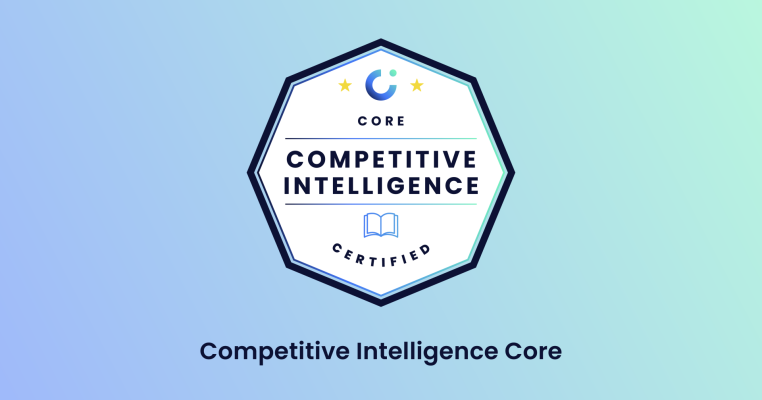In this article, we’ll show you how to analyze a competitor's website and materials.
When you examine competitors’ websites and their materials, you gain valuable insights that help your organization beat the competition.
So understanding how to deconstruct your competitor's online presence is a crucial competitive intelligence skill.
As always, there are ethical and legal boundaries you must respect when doing this kind of analysis. Never fear, we’ll explore those too. 🫡
First, here’s how to get the job done. 👷
How to analyze a competitor’s website
Here are the 10 steps:
- Establish your aims
- Get the lay of the land
- Perform a content analysis
- Perform SEO analysis
- Assess their user experience (UX)
- Examine your competitor's product offerings
- Assess their social media presence
- Check up on customer feedback
- Read their news updates
- Analyze their job postings
1) Establish your aims
Before you start with any analysis, it’s crucial you get crystal clear on just what it is you want to achieve.
Do you want to identify weaknesses in your competitor’s strategy? Do you want to identify areas where their online presence is stronger than your own, to give your own online strategy some informed direction?
Is your analysis of their website just part of a larger overall competitor analysis, or is this all you’ll be doing?
Questions like these help orient your subsequent analysis. When you know what you want to see, it’s easier to distinguish signal from noise and draw solid conclusions.
2) Get the lay of the land
Start by… visiting your competitor's website.
Take a general look around.
You’ll want to note the design, layout, and user-friendliness of the site. A thoughtfully laid-out website is a sign of a business that knows what it’s doing. Particularly in the SaaS space, a website is a direct reflection of the probable product experience.
Prospective customers will be paying attention, and so should you.
Pay particular attention to the:
- Homepage,
- Product or service offerings,
- Any unique website features that differentiate the experience.
You should also look at the competitor’s support pages. These can give you a sense of the level of customer support your competitors provide.
Note down anything that jumps out at you. With time and practice (and through talking to customers and prospects yourself) your judgment about what’s important will improve.
For example, when analyzing multiple competitors’ websites, you’ll notice that many follow a similar pattern. When one deviates from the pattern, it’s often important.
3) Perform a content analysis
Now it’s time to examine the content on the website.
This includes:
- Blog posts,
- Articles,
- Product landing pages,
- Help documentation,
- And news updates.
Analyze the tone, style, and messaging used to understand this competitor’s target audience and brand identity.
4) Perform SEO analysis
When you dig further into your competitor’s articles, blog posts, and other online content, you can start to uncover information about their SEO and content strategy.
Competitive SEO analysis is solid gold. Quality content is time-consuming to produce, which means it’s not cheap. If a competitor is producing lots of high-quality content around certain topics, it’s because these topics are valuable to them.
Perhaps they’re associated with high search volume, and bring them a lot of leads. Or perhaps, they’re obsessed with appearing as an authority on a particular niche topic, but it increases trust in their brand.
5) Assess their user experience (UX)
Good competitor research should always come back to the customer.
At the end of the day, you’re trying to win the hearts and minds of the same people as your competitor.
That’s why paying attention to the user experience your competitors offer on their website is a must.
As you’re navigating their website, identify any usability issues, loading speed problems, or broken links. If certain areas of the website are more polished than others, ask yourself why pages on these topics have received more investment and attention.
Just like with the SEO analysis, there’s a good chance it’s because these sections of the website are more valuable to your competitor.
Plus, identifying areas of weakness in their website’s user experience can help you identify opportunities to exploit, winning you more market share.
6) Examine your competitors' product offerings
Whether you have access to a competitor’s products through their website or not, you should be able to learn more about them.
Some (but not all) websites will list pricing information. Almost all will have detailed information about their product offerings, helping you identify where and how they differ from your own.
Pay particular attention to any unique selling points (USPs) and pricing strategies they’re using. USPs form the basis of differentiation, so you can use this information to help build sales enablement material. Your sales reps will need to handle objections in the form of prospects bringing up these USPs. They’ll also need to know how and where your offerings differ from this competitor’s. Put this information in your sales battlecards for the best results.

7) Assess their social media presence
Your web research wouldn’t be complete without taking stock of the competitor’s social media presence, though.
Technically, you’re moving off-site at this point. But in certain industries and niches, like live events, businesses integrate their social media into their website experience.
Even if your competitor’s social media exists totally separately from their website, it pays to investigate their social media profiles and activity.
As part of your social media analysis, pay attention to follower engagement, content sharing, and any customer feedback or reviews. Use what customers are saying as a form of customer research. You can learn what customers like or dislike about this competitor’s products, the user experience, and even more.
8) Check up on customer feedback
Competitor websites are often a nifty portal into their customer feedback.
Businesses with lots of positive feedback will be less selective about what the feedback they share on their website (since so much of it is positive). Those that share aggregated Trustpilot scores, for example, usually have lots of customer feedback.
Whether a competitor features such feedback on its website or not, it’s worth actively seeking out feedback left for them across multiple platforms (Trustpilot and Google Reviews, for example). This will net you the most representative sample of consumer sentiment towards your competitor.
Look to understand what their customers appreciate, and what they complain about. This can give you an idea of the strengths and weaknesses of your competitors’ products, which can inform your own business strategy.
9) Read their news updates
Any business that has something to update people about will use its website to do so in the first instance.
For very large enterprises, press releases and keynote speeches, might also factor in. But these will almost always wind up on their website too within minutes of release.
Some competitors will also announce upcoming releases and even changes to products, new partnerships, and rebrands.
Analyze their strategic moves and changes in direction. Do your best to understand the motivations behind what they announce, too. Does what this reveals about their strategy and their view of the competitive landscape, and the future of the industry, reflect your own org’s beliefs and opinions?
10) Analyze their job postings
Finally, if your competitor has a job board, it can be very useful to analyze their job postings on their website.
This will show you what they’re prioritizing. Sudden surges in hiring activity can also tell you a lot. For example, if they suddenly start hiring a lot of product managers, they might be looking to make substantial changes to their products. A surge in data analysis hires clearly shows you they’re investing in understanding large volumes of data.

A note on competitive intelligence ethics
We can’t end without talking about the ethics of competitive intelligence gathering.
All the sources of intel, and all the methods we’ve described above, constitute fair, legal, collection of publicly available information.
There are ethical lines one shouldn’t cross when performing competitive intelligence and web research.
Here are perhaps the two most important:
Only access publicly available, legal information
First, you should only look to access information that’s publicly available. Let’s be clear – hacking, and any other method of extracting information you shouldn’t have access to, isn’t okay.
Unauthorized access to a competitor's website or systems is illegal and unethical. It's a criminal act, and even attempting to hack a closed, protected system, has severe consequences – including prison sentences.
Phishing is another practice you should avoid. This involves creating fake websites or emails to trick competitors into revealing sensitive information. It's a fraudulent practice that can result in anything from fines to imprisonment.
Focus on gathering information that’s publicly available, and be mindful of how you’re using this information. Don’t ever reproduce or use copyrighted materials or trademarks without permission. Always respect intellectual property rights.
Represent yourself truthfully
You also shouldn’t misrepresent yourself.
Falsifying your identity, affiliation, or intentions to obtain information from competitors is deceptive and unethical.
The penalty for misrepresentation varies. This is because some forms of misrepresentation count as fraud, which carries a possible prison sentence.
The definition of fraud is “dishonestly making a false representation, with the intention of gain for yourself or someone else, or to cause loss to another or to expose another to a risk of loss”.
Regardless of whether misrepresentation counts as fraud or not, you should always be honest and transparent in your interactions.
So what does it all mean?
Your ability to sift through all of these factors (as well as factors from sources that don’t relate to your competitor’s website or online presence), and pull meaningful conclusions from them about:
- What this tells you about your competitor’s strategy, and
- How (if at all) this should alter or inform your own business strategy,
…is the very essence of being a successful competitive intelligence pro.
Want to learn the skills necessary? Bring yourself up to speed with Competitive Intelligence: Core. 👇
Give yourself an unfair advantage
Our newest competitive intelligence course lifts the lid on the frameworks and processes experts use to deliver impactful intel with confidence.
You can expect:
- A 100% self-paced and online course packed with competitive wisdom so you can stop worrying and start winning.
- Bonus features from established competitive professionals to give you an unfair advantage.
- 6 downloadable, customizable templates and frameworks that make analysis a cinch.

Competitive Intelligence: Core
We'll show you how to:
- 👑 Lead development of your org’s all-important competitive positioning.
- 🦾 Master CI’s essentials, including its most powerful research techniques.
- 🚀 Arm sales and customer success with intel to skyrocket win rates and turn down churn.
- 🧠 Offer leaders critical intel that informs their decision-making and strategy.
- 📈 Elevate CI’s role within your org to ensure career progression.





.png?v=09cf73b4b5)